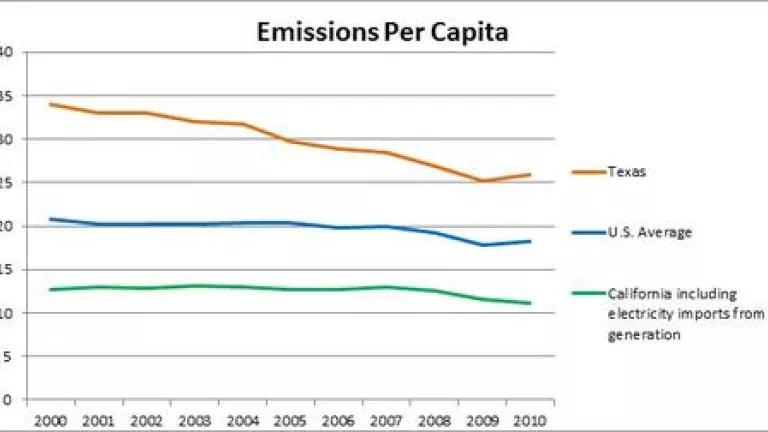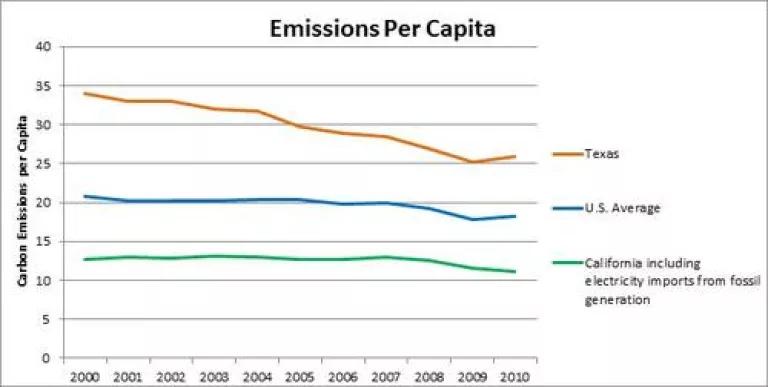
The federal government’s energy statistics agency issued its latest state energy-related greenhouse gas emissions report card on Monday, which compares how states’ energy systems stack up relative to a few performance indicators, such as per capita emissions and carbon intensity (which measures how much economic output each state produces for every ton of carbon emitted). Not surprisingly, the Energy Information Administration (EIA) report puts California at the head of the class: the Golden State ranks in the top 5 both for lowest emissions per capita and carbon intensity.
Yet one media outlet trumpeted a different conclusion – the altogether unsurprising fact that California is the second largest emitter overall of any state, and the altogether misleading claim that California is lagging behind the rest of the pack at reducing emissions.
Both claims miss the forest for the trees.
The first claim is correct: California emits more carbon from its energy use than any state save Texas. But California is also far and away the nation’s most populous state, the third largest oil producing and refining state, and the ninth-largest economy in the world. Compared to Texas – the nation’s largest emitter at nearly double California’s tally (despite two-thirds of California’s population) – California emits less than half the emissions per capita.

The second claim, regarding California’s pace of emission reductions, requires a bit more background. First, as a leader on clean energy policies since at least the 1970s, California started at a much lower baseline than most of the other states. In 2000, the starting year for EIA’s analysis, California was already emitting roughly half the emissions per capita than the current national average.
Second, EIA’s data attributes state ‘responsibility’ for emissions based on the location of the “smokestack,” rather than who is responsible for causing the emissions (which is particularly misleading for power sector emissions). While this means California’s energy-related emissions are slightly higher than what EIA projects (but still well below its nearest competitors and the national average, as seen in the chart above), it also means EIA does not credit emission reductions to states – like California – that have moved aggressively to replace imports from high-emitting resources like coal plants with cleaner sources (assigning those reductions instead to the state where the plants are located).
Since 2006, California's Emissions Performance Standard has prohibited the state's electric utilities from making new long-term investments in high-emitting resources such as conventional coal-fired generation, requiring them instead to meet the state’s resource needs with energy efficiency and cleaner sources of energy. For example, just two months ago, Los Angeles Mayor Antonio Villaraigosa announced the city’s Department of Water and Power (the nation’s largest municipally-owned utility) will exit its contract with the Intermountain Power Project – a large coal-fired plant in Utah – two years early and replace it with energy efficiency, renewables, and a much smaller, combined-cycle gas unit. Under EIA’s methodology, those reductions will show up in Utah’s rankings, but they came about from California policy.
But the most instructive finding of EIA’s report pertains to states’ relative carbon intensity. California leads the nation in total manufacturing output (which accounts for roughly 12% of gross state product, consistent with the national average), yet thanks in part to its long commitment to energy efficiency gets nearly twice the overall economic output per ton of carbon emitted than its Lone Star counterpart. In other words, California has effectively “decoupled” economic growth from carbon emissions, much as it has for electricity consumption (the state’s per capita electricity consumption has remained flat for more than four decades, while its economy has increased nearly threefold).

Despite a report to the contrary, the takeaway from EIA’s latest state emission report is clear: California remains at the forefront of state-led efforts to reduce greenhouse gas emissions, and continues to grow its economy. Under the banner of its comprehensive climate law (AB 32), the state is poised for even more progress.
Now that’s something to brag about.
This post was co-authored by Stefanie Tanenhaus



